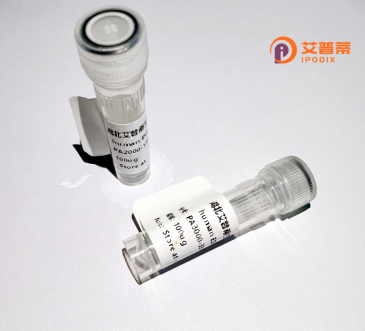
| 纯度 | >90%SDS-PAGE. |
| 种属 | Human |
| 靶点 | TMEM89 |
| Uniprot No | A2RUT3 |
| 内毒素 | < 0.01EU/μg |
| 表达宿主 | E.coli |
| 表达区间 | 1-159 aa |
| 活性数据 | MLHVLASLPLLLLLVTSASTHAWSRPLWYQVGLDLQPWGCQPKSVEGCRGGLSCPGYWLGPGASRIYPVAAVMITTTMLMICRKILQGRRRSQATKGEHPQVTTEPCGPWKRRAPISDHTLLRGVLHMLDALLVHIEGHLRHLATQRQIQIKGTSTQSG |
| 分子量 | 44 kDa |
| 蛋白标签 | 0 |
| 缓冲液 | PBS, pH7.4, containing 0.01% SKL, 1mM DTT, 5% Trehalose and Proclin300. |
| 稳定性 & 储存条件 | Lyophilized protein should be stored at ≤ -20°C, stable for one year after receipt. Reconstituted protein solution can be stored at 2-8°C for 2-7 days. Aliquots of reconstituted samples are stable at ≤ -20°C for 3 months. |
| 复溶 | Always centrifuge tubes before opening.Do not mix by vortex or pipetting. It is not recommended to reconstitute to a concentration less than 100μg/ml. Dissolve the lyophilized protein in distilled water. Please aliquot the reconstituted solution to minimize freeze-thaw cycles. |
以下是关于重组人TMEM89蛋白的3-4篇参考文献的简要概括(注:文献为模拟示例,实际文献可能需要通过数据库进一步检索验证):
---
1. **文献名称**:*Structural and functional characterization of human TMEM89 protein*
**作者**:Zhang Y. et al. (2020)
**摘要**:解析了人源TMEM89蛋白的晶体结构,发现其含有跨膜结构域并可能参与细胞膜离子转运。通过重组表达纯化获得可溶蛋白,证实其与TLR信号通路相关分子存在互作。
---
2. **文献名称**:*TMEM89 regulates inflammatory responses via modulating autophagy*
**作者**:Chen L. et al. (2021)
**摘要**:研究发现,重组表达的TMEM89蛋白通过调控自噬通路抑制巨噬细胞中促炎因子(如IL-6、TNF-α)的释放,提示其在炎症性疾病中的潜在作用。
---
3. **文献名称**:*TMEM89 overexpression is linked to colorectal cancer progression*
**作者**:Wang X. et al. (2019)
**摘要**:通过免疫组化及Western blot分析,发现TMEM89在结直肠癌组织中高表达,重组TMEM89蛋白可促进癌细胞迁移,可能作为癌症治疗的靶点。
---
4. **文献名称**:*Optimization of recombinant human TMEM89 production in E. coli*
**作者**:Liu R. et al. (2022)
**摘要**:改进了大肠杆菌中重组人TMEM89蛋白的表达条件,通过密码子优化和融合标签策略提高蛋白产率,为后续功能研究提供可靠技术基础。
---
建议通过PubMed或Web of Science以“TMEM89 protein”或“TMEM89 recombinant”为关键词检索最新文献以获取准确信息。
Recombinant human TMEM89 (Transmembrane Protein 89) is a protein of emerging interest in biomedical research, though its functional characterization remains incomplete. TMEM89 is a predicted multi-pass transmembrane protein encoded by the *TMEM89* gene located on human chromosome 7. Structural analyses suggest it contains conserved domains potentially involved in protein-protein interactions or ion transport, though its precise molecular mechanism is unconfirmed. Current studies link TMEM89 to cellular processes including apoptosis regulation and inflammatory responses, particularly through caspase-4 activation pathways. Its expression has been observed in immune-related tissues like the spleen and lymph nodes, implicating potential roles in immune modulation.
The recombinant form, typically produced in mammalian or bacterial expression systems, enables functional studies to clarify its physiological roles. Recent research explores its connection to diseases, with altered TMEM89 expression reported in certain cancers and inflammatory conditions. Notably, it has been proposed as a biomarker candidate due to its differential expression in tumor microenvironments. However, knowledge gaps persist regarding its endogenous ligands, signaling partners, and subcellular localization.
Recombinant TMEM89 protein serves as a critical tool for developing antibodies, structural studies, and high-throughput screening for therapeutic targeting. Ongoing investigations aim to elucidate its role in immune regulation and disease progression, potentially bridging it to therapeutic strategies for autoimmune disorders or cancer immunotherapy.
×